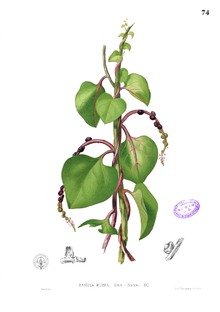| Basellaceae | |
|---|---|

| |
| Basella alba (rubra) from Blanco (c. 1880) | |
| Scientific classification | |
| Kingdom: | Plantae |
| Clade: | Tracheophytes |
| Clade: | Angiosperms |
| Clade: | Eudicots |
| Order: | Caryophyllales |
| Family: | Basellaceae Raf.[1] |
| Genera | |
|
See text | |
Basellaceae is a family of flowering plants in the order Caryophyllales, in the clade core eudicots, according to the Angiosperm Phylogeny Group. The family comprises 19 known species of herbaceous plants in four genera:[2]
All the species are climbing or trailing vines. Two species cultivated as food – Basella alba (Malabar spinach) and Ullucus tuberosus (ulluco) – have been bred to a more erect, compact form. Three species grow tubers – Anredera cordifolia and A. vesicaria produce them in the leaf axils or at the base of the stem and U. tuberosus at the end of stolons. Leaf blades vary in shape between species, within species, and even on an individual plant.[3]
The two cultivated species are of economic importance.
YouTube Encyclopedic
-
1/4Views:1 15318 7293 518492
-
MALABAR SPINACH | Alugbati | Propagation | Benefits and Uses
-
Malabar spinach with trellis
-
Basella alba
-
Basella/Malabar Spinach cultivation, cytology, taxonomy for NEET/ICAR-JRF /SRF/NET/AFO/UG/PG/Ph.D./
Transcription
References
- ^ Angiosperm Phylogeny Group (2009), "An update of the Angiosperm Phylogeny Group classification for the orders and families of flowering plants: APG III", Botanical Journal of the Linnean Society, 161 (2): 105–121, doi:10.1111/j.1095-8339.2009.00996.x, hdl:10654/18083
- ^ Christenhusz, M. J. M.; Byng, J. W. (2016). "The number of known plants species in the world and its annual increase". Phytotaxa. 261 (3). Magnolia Press: 201–217. doi:10.11646/phytotaxa.261.3.1.
- ^ Eriksson, Roger (2007). "A Synopsis of Basellaceae". Kew Bulletin. 62 (2): 298.
External links
 Media related to Basellaceae at Wikimedia Commons
Media related to Basellaceae at Wikimedia Commons- photographs
- links at CSDL Archived 2008-10-12 at the Wayback Machine
- Basellaceae in BoDD – Botanical Dermatology Database
